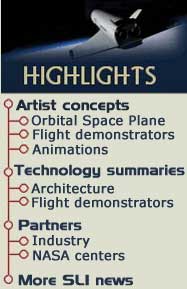|
OSP
TECH SUMMARY:
Architecture System Design
The
Orbital Space Plane program supports NASA's mission to transport
International Space Station crews safely, reliably and affordably.
The Orbital Space Plane will augment NASA's current capability
to provide crew rescue, crew transfer and contingency cargo
such as supplies, food and other needed equipment to and from
the Space Station while also enabling a larger permanent crew
to occupy the orbiting research facility, increasing science
and research capabilities in space.
Initially, NASA intends for the development of the Orbital
Space Plane to result in a crew rescue vehicle for the Space
Station that can depart safely and quickly in the event of
an emergency or an injured or ill crewmember. The new system
will be able to quickly separate from the Space Station under
emergency conditions and return to Earth to provide definitive
medical care to a disabled crewmember within 24 hours. The
initial operation of the vehicle is planned for no later than
2010 and will be launched aboard an expendable launch vehicle
(ELV).
By 2012, the Orbital Space Plane system will have the capability
to ferry crew and light cargo to and from the Space Station.
In time, the system could become the foundation for a crew
transfer vehicle routinely flown to space on a new launch
vehicle.
NASA
envisions that the new system may use the same vehicle or
a different version of the same vehicle to provide both the
crew rescue and crew transfer capabilities.
Designed to be safer than current space transportation systems,
the Orbital Space Plane will offer on-orbit maneuverability,
quicker preparations and turnaround time between missions.
In addition, the plane will be designed to meet all applicable
Space Station requirements for visiting and attached vehicles.
Based
largely on existing technologies, the Orbital Space Plane
would provide safe, affordable access to the International
Space Station. The Orbital Space Plane will be able to support
a Space Station crew rotation of four to six months. It will
be operable through at least 2020, although it will be designed
for longer life.
Four
groups of concepts are being considered for the physical design
of the space plane itself - or the vehicle architecture: a
capsule, a lifting body, a sharp body with wings and a blunt
body with wings. Boeing Phantom Works of Huntington Beach,
Calif., Lockheed Martin Corp. of Denver; and a team including
Orbital Sciences Corp. of Dulles, Va., and Northrop Grumman
of El Segundo, Calif. - are the prime contractor teams designing
potential candidates for the vehicle and its associated systems,
including ground operations and all supporting technologies
needed to conduct a mission to and from the International
Space Station. Initial concepts of the space plane will be
delivered to NASA in October 2003 during the Systems Requirements
Review. A decision to develop a full-scale vehicle is expected
by late 2004.
The
Orbital Space Plane Program is managed by the Office of Aerospace
Technology at NASA Headquarters and supported by NASA Centers
across the country.
|
